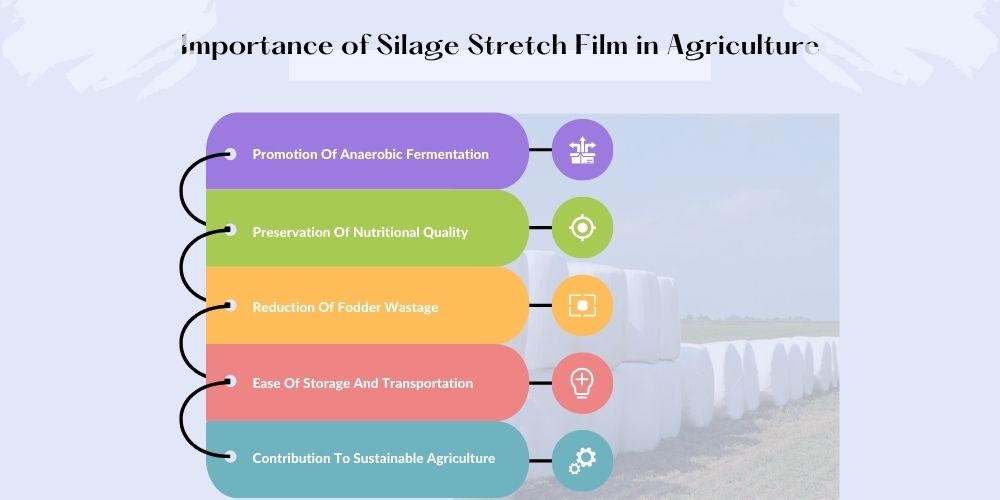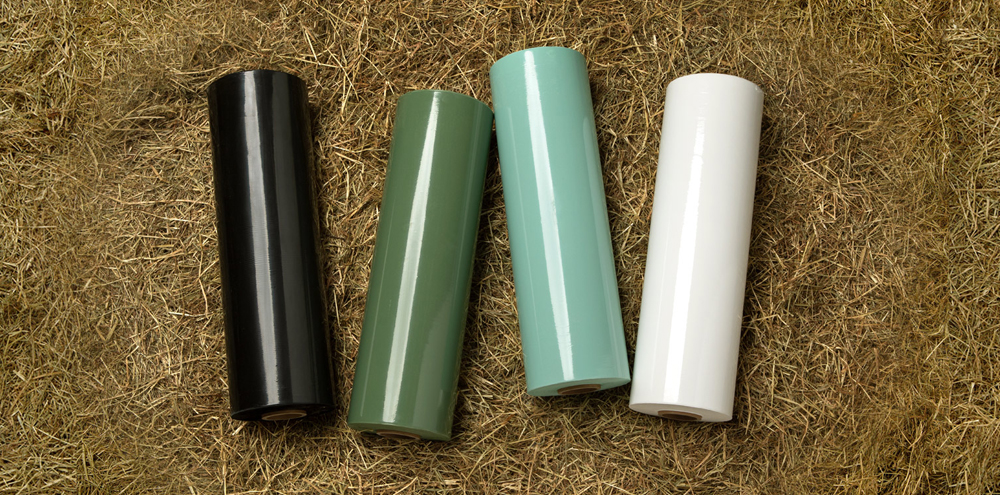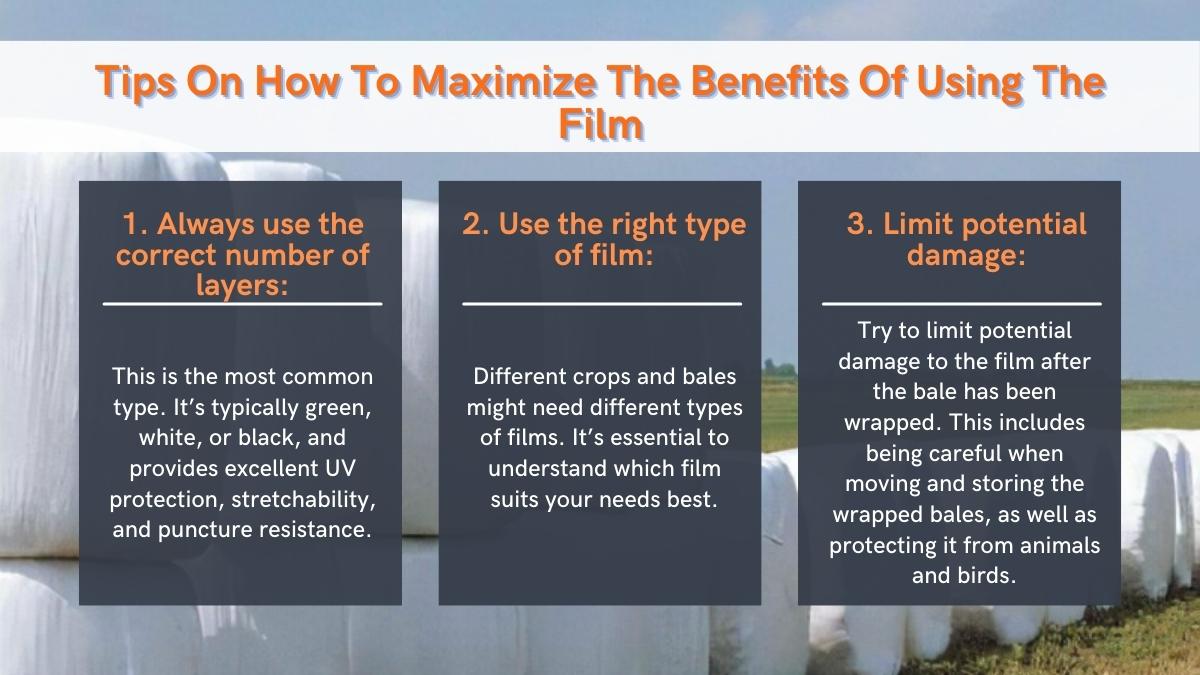I. Introduction
Leveraging a symbiotic blend of technological innovation and time-tested agricultural practices, silage stretch film stands as a pillar of modern farming techniques. This purpose-engineered plastic material serves as an impenetrable defense against adverse environmental elements such as oxygen and moisture, thus preserving the integrity and enhancing the nutritional profile of silage. Beyond its protective role, silage stretch film acts as an enabler of anaerobic conditions essential for the propagation of lactic acid bacteria, the key driver of the fermentation process. The resultant fermented silage is a nutrient-rich fodder that plays a pivotal role in elevating the health and productivity of livestock. Silage stretch film significantly curbs fodder wastage, aligning with the principles of sustainable farming and boosting economic viability. This text delves into the critical role of silage stretch film as a cornerstone in the agricultural sphere, underscoring its contributions to sustainable and successful farming practices.II. What is Silage Stretch Film?
A. Definition of Silage
Silage constitutes a form of fodder, produced from fresh vegetation such as grasses, leguminous plants, or cereals, which undergoes a preservation process via fermentation. This metabolic conversion—termed ensiling—involves the storage of the verdant material in a controlled, oxygen-free environment. This can be within a silo, securely wrapped in a specialized plastic film, or ensconced within a covered pit. The paramount objective of this process is to safeguard and retain the nutrient richness of the green fodder, enhancing its palatability for livestock consumption at subsequent stages.
B. Explanation of Silage Stretch Film and Its Purpose
Silage stretch film is a type of plastic film used extensively in the agricultural sector, especially in the process of ensiling. This specialized wrap is used to tightly seal and protect fermenting fodder from external factors such as air and moisture, which could affect the quality of the silage. The purpose of the silage stretch film is twofold. Firstly, it provides an airtight seal that promotes anaerobic fermentation, inhibiting the growth of unwanted bacteria and fungi, and thereby preserving the nutritional value of the silage. Secondly, the film protects the silage from unfavorable weather conditions, pests, and physical damage during storage and transportation.| Uses of Silage Stretch Film | Precautions When Using Silage Stretch Film |
|---|---|
| 🔄 Promotes anaerobic fermentation, enhancing silage quality | Proper tension must be maintained when applying the film |
| 🛡️ Protects silage from air, moisture, and pests | Regular checks for punctures or tears to maintain the airtight seal |
| ☔ Shields silage from adverse weather conditions | Correct overlap should be ensured during wrapping |
| 📦 Prevents physical damage during storage and transportation | Should be used in conjunction with a quality silage inoculant for optimal results |
| 🍀 Helps reduce fodder wastage | Must be disposed of responsibly to mitigate environmental impact |
C. Details on How It Is Used in Agricultural Practices
In agricultural practices, the silage stretch film is used during the ensiling process after the green vegetation has been harvested and slightly dried. The vegetation is grouped together into a compact bundle, often referred to as a bale. This bale is then tightly wrapped with multiple layers of the silage stretch film. The wrapping can be done using specialized machinery, which ensures a tight and consistent wrap. It’s important to cover all exposed areas to prevent air from entering the bale. Once wrapped, these bales are left to ferment in the field or are transported to a storage site. The film remains on the bale until it’s time to feed the silage to livestock, at which point it’s carefully removed to prevent plastic particles from mixing with the fodder. By using silage stretch film, farmers can effectively store and preserve fodder in an environmentally controlled state, allowing them to feed their livestock high-quality nutrients regardless of the season. This practice improves the efficiency of farming operations and contributes to sustainable livestock production.III. Importance of Silage Stretch Film in Agriculture

1.Promotion of Anaerobic Fermentation
Silage stretch film is instrumental in promoting the anaerobic fermentation process essential for the production of high-quality silage. By providing an airtight seal, the film creates an oxygen-deprived environment, which is conducive for the growth of lactic acid bacteria. This bacteria breaks down the sugars in the silage, leading to a decrease in pH and the preservation of the fodder’s nutrients. Without this controlled environment, other detrimental microbes could thrive, potentially leading to the spoilage and loss of nutritional value in the silage.2.Preservation of Nutritional Quality
The quality of fodder is vital for the health and productivity of livestock. Silage stretch film aids in preserving the nutritional value of silage by providing a barrier against oxygen, pests, and adverse weather conditions. Oxygen exposure could lead to the growth of aerobic organisms that deteriorate the silage, while pests and harsh weather conditions can physically damage it. By protecting the silage from these threats, the film ensures that the livestock receives nutritionally-rich feed, contributing to their overall health and productivity.3.Reduction of Fodder Wastage
Silage stretch film significantly reduces fodder wastage, a crucial aspect of achieving sustainable farming practices and economic efficiency. By providing an airtight seal and protecting the silage from external threats, the film prevents spoilage and ensures that the maximum amount of harvested fodder is usable. This reduction in wastage translates into cost savings, making silage stretch film an economically beneficial tool in agricultural practices.4.Ease of Storage and Transportation
The application of silage stretch film enhances the manageability, storage efficiency, and logistics of silage. The compact dimension of silage bales, once wrapped in the film, maximizes storage utility and optimization. Additionally, the protective layer furnished by the film shields the ensiled fodder from potential physical damage during transit, ensuring that the fodder retains its optimal quality upon arrival at its destination.5.Contribution to Sustainable Agriculture
IV. Types of Silage Stretch Films
Silage stretch films are an essential agricultural tool, especially in the area of bale wrapping. They offer numerous benefits for preserving the nutritional value of silages, reducing fodder spoilage, and enhancing the overall efficiency of the farm’s productivity. There are several different types of silage stretch films, each with its unique properties, benefits, and drawbacks.Detailed Description of Different Types of Silage Stretch Films
There are several types of silage stretch films, each designed to meet specific needs on the farm. 1. Standard Silage Stretch Film: This is the most common type. It’s typically green, white, or black, and provides excellent UV protection, stretchability, and puncture resistance.
2. Pre-Stretched Silage Stretch Film: This film is stretched during manufacturing, which makes it lighter and easier to apply. It’s highly efficient and can wrap more bales per roll compared to standard films.
3. BIO-degradable Silage Stretch Film: Made from sustainable, compostable materials, this type of film is designed to decompose naturally over time, reducing plastic waste on the farm.
4. Barrier Film: This type of film offers the highest level of oxygen barrier properties. It effectively prevents oxygen ingress, reducing fodder spoilage and maintaining a high nutritional value.
1. Standard Silage Stretch Film: This is the most common type. It’s typically green, white, or black, and provides excellent UV protection, stretchability, and puncture resistance.
2. Pre-Stretched Silage Stretch Film: This film is stretched during manufacturing, which makes it lighter and easier to apply. It’s highly efficient and can wrap more bales per roll compared to standard films.
3. BIO-degradable Silage Stretch Film: Made from sustainable, compostable materials, this type of film is designed to decompose naturally over time, reducing plastic waste on the farm.
4. Barrier Film: This type of film offers the highest level of oxygen barrier properties. It effectively prevents oxygen ingress, reducing fodder spoilage and maintaining a high nutritional value.
| Type of Stretch Film | Standard Silage Stretch Film | Pre-Stretched Silage Stretch Film | BIO-degradable Silage Stretch Film | Barrier Film |
|---|---|---|---|---|
| 📏 Conventional size | Standard widths available | Typically narrower due to pre-stretching | Varies based on the manufacturer | Standard widths available |
| 💪 Tear resistance | High | Moderate | Depends on the compostable materials used | Very high |
| 🧱 Material | Polyethylene | Polyethylene, pre-stretched | Compostable materials | Multi-layered polyethylene |
| 📍 Application place | Versatile, can be used in various farming environments | Best used in controlled environments to prevent re-stretching | Ideal for farms prioritizing sustainability | Recommended for locations with high ambient oxygen levels |
| 🌿 Environmental impact | Non-biodegradable | Non-biodegradable | Biodegradable, compostable | Non-biodegradable, but provides excellent oxygen barrier |
| 📦 Storage conditions | Should be stored away from sunlight and heat | Should be stored away from sunlight and heat | Storage conditions vary depending on the materials used | Should be stored away from sunlight and heat |
| 💰 Budget | Economical | Slightly more expensive, but more efficient | Usually more expensive due to sustainable materials used | Most expensive due to superior oxygen barrier properties |
| ✔️ Advantages | Excellent UV protection, stretchability, and puncture resistance | Lighter, easier to apply, more bales per roll | Environmentally friendly, reduces plastic waste | Prevents oxygen ingress, reduces fodder spoilage, maintains high nutritional value |
| ❌ Disadvantages | Non-biodegradable, potential environmental impact | Could re-stretch if not applied properly | Not as tear-resistant as other types | More expensive, might not be cost-effective for small-scale farms |
V. Tips for Using Silage Stretch Film Efficiently
It’s pivotal to understand the ways you can efficiently use silage stretch film in your agricultural undertakings. Proper application, maximum utility and effective storage and maintenance can significantly improve your experience with silage stretch film. Let’s delve deeper into each of these areas.A. Advice on the Application of the Film
Applying the silage stretch film correctly is the first step to achieving optimum results. Always ensure the bale surface is as smooth as possible to aid in the film’s application. The square shouldering of the bale is vital for optimum sealing. When applying, ensure the correct overlap and stretch. While the exact overlap might vary based on the product, it’s recommended to have a minimum of 50% overlap. Lastly, the right tension is crucial. The film should be stretched to its optimum to ensure a good seal and better oxygen barrier.B. Tips on How to Maximize the Benefits of Using the Film
Maximizing the benefits of your silage stretch film mostly depends on how you handle the product. Here are some tips to enhance its effectiveness:
C. Information on Proper Storage and Maintenance of the Film
Proper storage of the silage wrap before and after use is paramount. The rolls should be stored upright in their original packaging and kept away from direct sunlight and heat sources. It’s also recommended to use the film within 12 months of purchase. After applying, stored bales should ideally be kept on a soft surface, such as sand or soil, and away from sharp objects that may damage the film. Regularly inspect the bales for any signs of damage, and if detected, repair them immediately with a specially designed patching tape. By adhering to these tips and guidelines, you’re guaranteed to make the most of your silage stretch film and contribute to a more successful and efficient agricultural operation.VI. Potential Challenges in Using Silage Stretch Film
The usage of silage stretch film provides several benefits which include maintaining the nutritional value of forage, decreasing spoilage, and minimizing feed costs. However, it is not without its potential challenges. In this section, we will explore some of the common difficulties farmers may encounter when using silage stretch film and suggest some practical solutions to overcome these challenges.A. Common difficulties or issues farmers might encounter
| Problems Associated with Silage Stretch Film | Description |
|---|---|
| 🔍 Quality of Silage Film | Poor-quality silage stretch film might not provide the necessary oxygen barrier, potentially leading to degradation of the silage’s nutritional value. |
| 📦 Storage Conditions | Incorrect storage of silage bales could damage the stretch film, causing exposure of the silage to oxygen and leading to spoilage. |
| ☔ Weather Conditions | Harsh outdoor conditions like excessive rain, high wind, or extreme sunlight can affect the durability and effectiveness of the stretch film. |
| 💰 Cost and Waste Management | The ongoing cost of purchasing silage stretch film and the problem of waste disposal after use can pose significant challenges. |
B. Suggestions on how to overcome these challenges
| Solutions to Problems Associated with Silage Stretch Film | Description |
|---|---|
| 🏪 Choose Quality Products | Overcome poor-quality silage film by purchasing from reliable suppliers. Look for UV-stabilized, durable films with a high oxygen barrier. |
| 🏗️ Proper Storage | Store silage bales on a clean, smooth surface and consider covering them with a protective net or sheet to prevent film damage. |
| ☀️ Monitor Weather Conditions | Try to make silage when the weather conditions are favorable. Monitoring weather forecasts can help avoid damage to the silage film. |
| 🔄 Consider Costs and Waste Management | Include the cost of the stretch film in the overall silage production calculation. Opt for recyclable silage stretch film to manage waste effectively. |
VII. Conclusion
In essence, silage stretch film is a transformative tool in agriculture, essential for preserving silage quality and promoting efficient fermentation. It minimizes fodder wastage, aids in storage and transportation, and contributes to sustainable farming practices. With various types available, it’s pivotal to choose the right film that aligns with your farm’s needs and sustainability goals.VIII.RFQ

A: Silage stretch film is primarily made from polyethylene. It undergoes an extrusion process where the plastic is melted and then blown into a thin film. It is then cooled and wound onto rolls.
A: Differences in silage stretch film types come down to their thickness, UV stability, elasticity, tear resistance, and whether they’re biodegradable. The right choice depends on specific needs and conditions of your farm.
A: Many farms globally have reported benefits from using silage stretch films, including reduced fodder waste, better silage quality, and improved farm efficiency. Specific case studies can be found in agricultural journals or farming websites.
A: Alternatives include silage bags, silage pits, or hay bales. However, these may not provide the same level of protection from oxygen and pests as silage stretch films.
A: Traditional silage stretch film is not biodegradable and can contribute to plastic waste. However, there are now biodegradable options available that decompose over time, reducing their environmental impact.
A: Yes, innovations include films with better oxygen barrier properties, UV resistance, and biodegradability, among others.
A: It’s important to apply the film evenly and tightly to create an airtight seal. Also, ensure the bales are stored on a smooth, clean surface to prevent puncturing the film.
A: Keep it in a dry, cool place away from direct sunlight. Also, handle with care to prevent any tears or punctures.
A: Quality silage stretch film can be purchased from agricultural supply stores or online from trusted manufacturers. Be sure to read reviews and choose a reliable supplier.
A: Some recycling facilities accept agricultural plastics. Check local regulations. For biodegradable films, follow manufacturer instructions for proper disposal.














